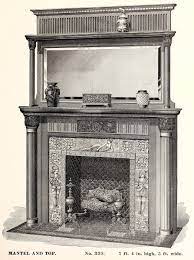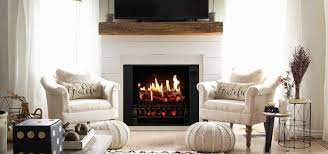Fireplace mantles are decorative accents in a room. You might wonder how high a fireplace mantel should be.
The height of a fireplace mantel is at least 12 inches above a firebox. Classic add-on mantels are between 54 and 60 inches high off the ground. A fireplace’s design influences the height of a mantel. Fireplace mantels are functional and decorative and fit a room’s style and design.
Whether renovating or building from scratch, a fireplace is functional, and a mantel adds an aesthetic feel. The size of a mantel depends on a room’s use, design and scale. Mantels can vary from ornate reproductions of a bygone era to slick accents that are well-designed and thought about. How high a fireplace mantel should be is more than aesthetics.
What Is The Height For A Mantel Over A Fireplace


Suppose you are designing a home or room from scratch or considering renovating and adding a fireplace. In that case, you will have to consider what’s possible. A fireplace can be designed to add ambiance and is a cost-efficient way to warm a room or a home. No doubt, everyone knows that a fireplace is also the coziest spot in a home.
Most homeowners choose a fireplace mantel as both a decorative and functional item. Framing a fireplace depends on the look and feel of your home and the room. You can build a fireplace with brick or stone or simply drop a metal firebox into a space in a wall.
Designing a fireplace as an accent or a feature can be like those in a farmhouse, a Victorian manor, or one that follows modernist and simple, clean lines with no ornamentation. For many designers and homeowners, a mantel is part and parcel of not only a room with a fireplace. The mantel is a specific accent and focus in a room.
How high and the length and shape of a mantel is often one of the most challenging choices to make. There are a range of choices for a mantel which nowadays are decorative and functional. A mantel frames a fireplace opening and there are many standard sizes to match equally standard size fireboxes.
The original design of a mantel or mantelpiece fitted around the opening of a fireplace and had a hood that stopped smoke from a wood-burning fire from filling a room. A mantel with a hood was the way to direct the smoke up a chimney. The design of fireplaces and mantels has been adapted, even modernized, to be less ornamental.
Mantels are accents and less like the display shelf of photographs and an oil lamp as in the past. Contemporary mantels are large pieces of driftwood, sometimes off shipwrecks, and a focal point and decorative accent. There are many variations in the size and shape of a fireplace mantel. A mantel can be in brick and stone and built by an artisan builder.
A fireplace mantelpiece is often chosen as a talking point – a mantel salvaged from a demolished monastery site or an heirloom from a family home, one hand-selected like an antique beam.
Variations In The Height Of Fireplace Mantels
The height of a fireplace mantel differs. The fireplace’s design and the room’s look and feel influence the height of a mantel. A room’s ceiling height, and the wall at the back of the fireplace, play a part.
There, however, are standards that influence the height of a fireplace and mantel. These often have to do with safety regulations and techniques of building. But aesthetics often is the dominant feature.
As seen above, the height of a fireplace mantel will depend on a fireplace’s design. Whether you are replacing an existing mantel with a custom-made one, the room’s shape plays a part too. The wall height at the back of the fireplace matters, as well as the ceiling height. The aspects mentioned have primarily to do with aesthetics.
Whether you choose a modern look and feel or the style of a country or farmhouse look, you need to be aware of standard heights, like:
- A mantel must be at least 12 inches above a firebox or a fireplace’s opening
The National Fire Protection Authority regulates the clearance distance between the top of a wood-burning firebox or a fireplace and the bottom of a mantel. A clearance between 11 and 12 inches, the minimum clearance, is calculated to be the actual width of a mantel. At this close distance, a clearance of about 12 inches allows for a 2-inch overhang.


The wider the mantel overhang, the higher or further away the mantel has to be from the fire opening. As the width of the mantel increases, so does the clearance distance have to be higher. The reason is to prevent the combustibles from setting the mantel alight, especially if the mantel is made out of wood.
You can do the calculations based on a starting minimum clearance of 12 inches between the top of a firebox and the underside of a mantel. Then, for every two inches of a mantel’s depth, add 2 inches to the minimum clearance.
The table below takes the height from the firebox floor as 24 – 30 inches. The height at which a mantel is put is calculated on the mantle’s width:
| Mantel Depth | Clearance between firebox & mantel | Height of Mantel from the firebox | Height of Mantel Room Floor |
| 2 inches | 12 inches | 11 – 12 inches | Approx. 36 – 42 inches |
| 4 inches | 14 inches | 13- 14 inches | Approx. 38 – 44 inches |
| 6 inches | 16 inches | 15-16 inches | Approx. 40 – 46 inches |
| 8 inches | 18 inches | 17-18 inches | Approx. 42 – 48 inches |
| 9-10 inches | 20 inches | 19 – 20 inches | Approx.44 – 50 inches |
The further a mantel projects (its depth), also increases the potential for as a fire hazard. That is the reason for the minimum clearance. The above averages are used as a guide – this is a 2-inch clearance added for every two inches that the width of a mantel is wide.
A classic Victorian fireplace mantel and even Art & Crafts mantels for fireplaces stand between 52 – 54 inches off the ground. The width of the mantelpiece is 9 inches – enough to put an oil lamp there – and is far enough away from the fire opening (or firebox) not to be damaged or even to catch alight.
The height of a mantel above a fireplace is more than just safety; the height at which a mantel is put also has aesthetic appeal.
Aesthetics And the Height Of A Mantel Above A Fireplace
As seen above, safety regulations determine the minimum height of a mantle above a fireplace. The deeper a mantel’s width is, the higher the mantel must be above the firebox. There is also a visual dimension as a mantel is used for decorative or accent pieces. Choosing a mantel is therefore not done quickly.
Fireplace mantels vary in size and shape, and a house’s design, and the ambiance you are looking for, will determine what kind of mantel you have at a fireplace. Besides the safety regulations and codes, a mantel must look right in relation to the fireplace.
The mantel must also fit the room and the height of the walls. These design features will say whether you go for a reproduction mantel, a beam, or a stone mantel.
A fireplace in a farm-style house could be one with old-world charm. The mantel is the accent as you walk in, a talking point, and one thing you don’t want to have is its height to jar your eye. So whether installing a free-floating mantel, or a replica, get the proper attention by installing the mantel at roughly 52 inches off the ground and not higher than 60 inches for balance.
Mantels Decorative Appeal
Mantels often are used as a shelf above a fireplace for displays. The displays depend on the mantel’s height and are designed to be visually attractive rather than awkwardly distracting if the height is not carefully considered.
Putting a mantel above a fireplace has to add balance to a space and be neither too high to make you wonder if the ornaments ever get dusted. Nor should a mantel be too low to be a safety hazard at an open wood-burning fire.
Designers suggest a mantel be installed at roughly shoulder level of an average of 5 feet 8 inches. The height, of course, also depends on the intended uses of a room. Even how the room is furnished, and the floor-to-ceiling height of the wall fireplace is in.
Conclusion
A mantel is an accent feature in a room, draws your attention when you walk into a room, and is a talking point. The height at which a mantel is put is not arbitrary. The height of a mantel above an open wood fire is both a safety and aesthetic decision. The dimensions of a room with a fireplace and a mantel matter too.
A mantel has functional and aesthetic appeal, but safety regulations come first. You should check your area’s housing regulations and fire codes before installing a mantel and a fireplace. The clearance height between a mantel and a fireplace should be at least 12 inches to avoid a fire.

